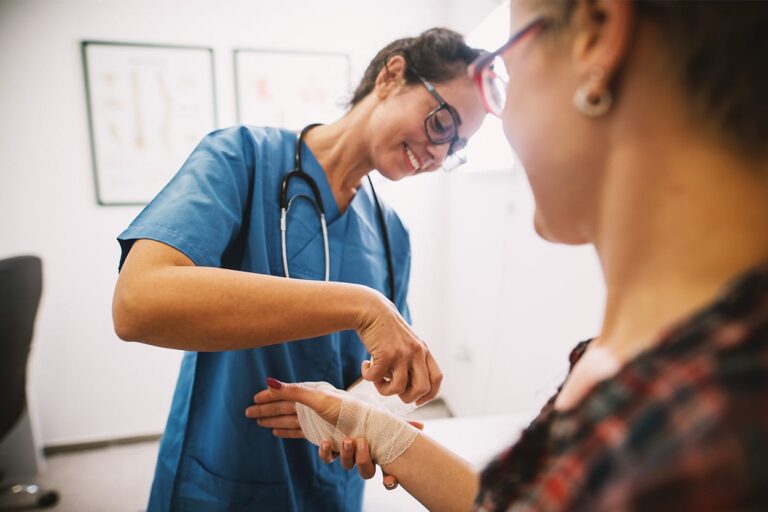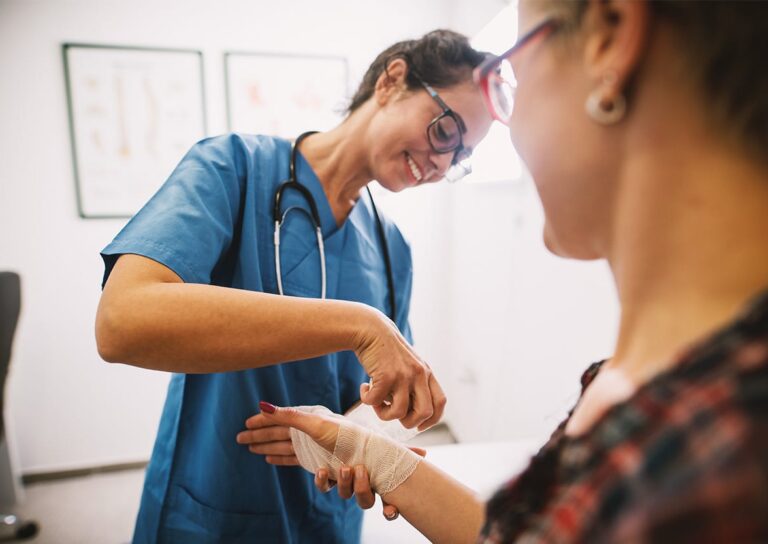Familiarize Yourself With Nursing Terms
Understanding the intricacies of the nursing profession and various terminology used can be a daunting task. One valuable tool that can help nursing students is a glossary of terms, specific to the nursing field. By familiarizing themselves with these specialized terms, individuals can gain a deeper understanding of the nursing profession, enhance their communication skills, and improve their performance on the job.
General Terms
Acute Care: A branch of secondary health care where a patient receives active but short-term treatment for a severe injury or episode of illness, an urgent medical condition, or during recovery from surgery.
Advanced Practice Registered Nurse (APRN): A nurse with post-graduate education in nursing. APRNs are prepared with advanced didactic and clinical education, knowledge, skills, and scope of practice in nursing.
Ambulatory Care: Care provided on an outpatient basis. Many surgeries and treatments are now provided on an ambulatory basis, while in the past they may have required hospitalization.
Assisted Living: A system of housing and limited care that is designed for senior citizens who need some assistance with daily activities but do not require care in a nursing home.
Bioethics: The study of the ethical issues emerging from advances in biology and medicine. It is also moral discernment as it relates to medical policy and practice.
Cardiology: The study and treatment of disorders of the heart and the blood vessels.
Certified nurse assistant or aide: an individual that helps patients with direct health care needs, often under the supervision of a nurse.
Chronic Care: Care and treatment rendered to individuals whose health problems are of a long-term and continuing nature.
Clinical Judgment: The interpretation or conclusion about a patient’s needs, concerns, or health problems, and/or the decision to take action (or not), use or modify standard approaches, or improvise new ones as deemed appropriate by the patient’s response.
Clinical Nurse Specialist (CNS): An advanced practice nurse who can provide expert advice related to specific conditions or treatment pathways.
Code of Ethics: The philosophical ideals of right and wrong that define the principles you will use to provide care to your patients. It’s a set of guiding principles that all members of a profession accept.
Critical Care: The specialized care of patients whose conditions are life-threatening and who require comprehensive care and constant monitoring, usually in intensive care units.
Critical Thinking: The ability to analyze and evaluate an issue in order to form a judgment. In nursing, it’s an essential component of professional accountability and quality nursing care.
Cultural Competence: The ability of healthcare providers to provide care to patients with diverse values, beliefs and behaviors, including tailoring healthcare delivery to meet patients’ social, cultural, and linguistic needs.
Delegation: The process for a nurse to direct another person to perform nursing specific tasks and activities.
End-of-Life Care: Care given to people who are near the end of life and have stopped treatment to cure or control their disease. End-of-life care includes physical, emotional, social, and spiritual support for patients and their families. The goal of end-of-life care is to control pain and other symptoms so the patient can be as comfortable as possible. End-of-life care may include palliative care, supportive care, and hospice care. Also called comfort care.
Evidence-Based Practice (EBP): The integration of clinical expertise, patient values, and the best research evidence into the decision-making process for patient care.
Geriatrics: The branch of medicine or social science dealing with the health and care of elderly people.
Health Literacy: The degree to which individuals have the capacity to obtain, process, and understand basic health information and services needed to make appropriate health decisions.
HIPAA: The Health Insurance Portability and Accountability Act. It provides data privacy and security provisions for safeguarding medical information.
Holistic Care: A form of healing that considers the whole person — body, mind, spirit, and emotions — in the quest for optimal health and wellness.
Home Health Care: Health care services provided in a patient’s home to promote, maintain, or restore health.
Homeostasis: The tendency of the body to seek and maintain a condition of balance or equilibrium within its internal environment, even when faced with external changes.
Hospice Care: A type of care and philosophy of care that focuses on the palliation of a chronically ill, terminally ill, or seriously ill patient’s pain and symptoms, and attending to their emotional and spiritual needs.
Infection Control: Procedures to prevent healthcare-associated infections (HAIs). Infection control includes hand hygiene, cleaning, disinfection, sterilization, vaccination, and isolation precautions.
Informed Consent: The process by which a fully informed patient can participate in choices about their health care.
Inpatient Care: Health care that a patient receives when formally admitted to a facility like a hospital or nursing home.
Interdisciplinary Team: A group of health care professionals from diverse fields who work in a coordinated fashion toward a common goal for the patient.
Licensed Practical Nurse (LPN): A nurse who has completed a practical nursing program and is licensed by the state to provide routine patient care under the direction of a registered nurse or a physician.
Long-Term Care: A variety of services which help meet both the medical and non-medical needs of people with a chronic illness or disability who cannot care for themselves for long periods.
NCLEX: The National Council Licensure Examination is a nationwide examination for the licensing of nurses in the United States and Canada.
Neurology: The branch of medicine dealing with disorders of the nervous system.
Oncology: A branch of medicine that specializes in the diagnosis and treatment of cancer. It includes medical oncology (the use of chemotherapy, hormone therapy, and other drugs to treat cancer), radiation oncology (the use of radiation therapy to treat cancer), and surgical oncology (the use of surgery and other procedures to treat cancer).
Outpatient Care: Medical care or treatment that does not require an overnight stay in a hospital or medical facility.
Palliative Care: A multidisciplinary approach to specialized medical and nursing care for people with life-limiting illnesses. It focuses on providing relief from the symptoms, pain, physical stress, and mental stress at any stage of illness.
Patient Advocacy: The act of speaking out for the patient’s rights and health. A patient advocate helps patients get the information they need, communicates their wishes to health professionals, and strives to improve the quality of healthcare.
Patient-Centered Care: A healthcare approach where the patient is seen as an individual, rather than just a case. This type of care considers the patient’s preferences and values, and involves them in all decisions about their health.
Pediatrics: The branch of medicine dealing with the health and medical care of infants, children, and adolescents.
Pharmacology: The study of drugs and their effects on the human body. This is a crucial part of nursing as medications are often a key component of patient treatment plans.
Primary Care: Health care provided by a medical professional with whom a patient has initial contact and by whom the patient may be referred to a specialist. Primary care professionals include doctors, nurses, nurse practitioners, and physician assistants.
Psychiatry: The branch of medicine focused on the diagnosis, treatment and prevention of mental, emotional and behavioral disorders.
Quality Improvement (QI): A systematic, formal approach to the analysis of practice performance and efforts to improve performance.
Quaternary Care: An extension of tertiary care in reference to advanced levels of medicine which are highly specialized and not widely accessed.
Registered Nurse (RN): A nurse who has graduated from a nursing program and met the requirements outlined by a country, state, province or similar licensing body to obtain a nursing license.
Rehabilitation: The process of helping a person who has suffered an illness or injury restore lost skills and regain maximum self-sufficiency.
Residential Care: Long-term care given to adults or children who stay in a residential setting rather than in their own home or family home.
Scope of Practice: Defines the procedures, actions, and processes that a healthcare practitioner is permitted to undertake in keeping with the terms of their professional license.
Secondary Care: Health care services provided by medical specialists and other health professionals who generally have specific expertise about a condition. Examples of medical situations needing secondary care services include cancer treatment, medical care for pneumonia and other severe and sudden infections, and care for broken bones.
Skilled Nursing Facility: A type of nursing home recognized by the Medicare and Medicaid systems as meeting long term health care needs for individuals who have the potential to function independently after a limited period of care.
Subacute Care: A level of care that is defined as more intensive than traditional nursing facility care, but less than acute care.
Telehealth: The use of digital information and communication technologies, like computers and mobile devices, to access health care services remotely and manage your health care.
Telemetry: The application of technology to monitor the physiological parameters of patients, often those with chronic diseases, from a distance.
Tertiary Care: Specialized consultative health care, usually for inpatients and on referral from a primary or secondary health professional, in a facility that has personnel and facilities for advanced medical investigation and treatment.
Triage: The process of determining the priority of patients’ treatments based on the severity of their condition.
Unlicensed assistive personnel: generalist care providers that are unlicensed and assist individuals with physical disabilities, mental impairments, and other health care needs with their activities of daily living

Registered Nurses Tools and Equipment
Becoming familiar with the tools and equipment used in the field of registered nursing is of utmost importance for aspiring nurses. These tools and equipment serve as vital instruments in delivering high-quality patient care and ensuring positive health outcomes. By developing a comprehensive understanding of these devices, nurses can navigate their work environment with confidence and efficiency, saving precious time in critical situations.
Catheters: a flexible tube inserted through a narrow opening into a body cavity, particularly the bladder, for removing fluid.
Cheat Sheets: These are pocket-sized guides that provide quick access to important information like heart rhythms, anatomy, lab draw orders, injection sites, and more.
Defibrillator: A device that gives a high energy electric shock to the heart of someone who is in cardiac arrest. This high energy shock is called defibrillation, and it’s an essential part in trying to save the life of someone who’s in cardiac arrest.
Feeding Pump: A medical device that delivers nutritionally complete feed, containing protein, carbohydrate, fat, water, minerals and vitamins, directly into the stomach, duodenum or jejunum.
Fetal Monitor: In labor and delivery settings, nurses use this device to track the unborn baby’s heart rate.
Forceps: A handheld, hinged instrument used for grasping and holding objects. Forceps are used when fingers are too large to grasp small objects or when many objects need to be held at one time while the hands are used to perform a task.
Gait Belt: A safety device used to help someone move, such as from the bed to a chair. The belt is also used to help hold up a person while they walk if they are too weak to walk on their own.
Glucometer: A device used to determine the concentration of glucose in the blood, typically used by diabetic patients.
Hand Sanitizer and Hand Cream: Nurses need to keep their hands clean at all times to protect themselves and their patients from germs and bacteria. Hand cream is also important to prevent skin from drying out due to frequent hand washing and sanitizing.
Hemostat: Also known as arterial forceps, these tools help nurses by clamping IV lines, arteries, and tubing. They can even hold a needle while suturing a wound.
Hospital Bed: A bed specially designed for hospitalized patients or others in need of some form of health care. These beds have special features both for the comfort and well-being of the patient and for the convenience of health care workers.
Intravenous (IV) Stand: A stand with a pole and hooks or slots that holds bags of fluids, such as saline or medication, for intravenous (IV) therapy.
Intravenous Pump: a medical device used to deliver fluids into a patient’s body in a controlled manner.
Lancets: These are used to make small punctures, such as a fingerstick, to obtain blood specimens.
Manual Resuscitators: These can be used to force air into a patient’s lungs if the patient stops breathing on their own.
Medical Penlight: A small flashlight used for a neurological examination of the eyes.
Nebulizer: A drug delivery device used to administer medication in the form of a mist inhaled into the lungs. They are commonly used for the treatment of respiratory diseases or disorders.
Nursing Clipboard: This tool allows nurses to carry patient files while easily accessing tools and other information they might need. Some nursing clipboards come with features like assessment charts, a timer, a calculator, and an alarm clock.
Otoscopes: An instrument designed for visual examination of the eardrum and the passage of the outer ear, typically having a light and a set of lenses.
Ophthalmoscopes: An instrument for inspecting the retina and other parts of the eye.
Personal Protective Equipment (PPE): Equipment worn to minimize exposure to hazards that cause serious workplace injuries and illnesses. These injuries and illnesses may result from contact with chemical, radiological, physical, electrical, mechanical, or other workplace hazards. PPE includes items like gloves, safety glasses and shoes, earplugs or muffs, hard hats, respirators, or coveralls, vests and full body suits.
Pulse Oximeter: Measures the proportion of oxygenated hemoglobin in the blood in pulsating vessels, especially the capillaries of the finger or ear.
Reflex Hammer: Nurses often need to perform neurological tests as part of patient examinations. A reflex hammer is used to test patient reflexes.
Retractable Pens: Nurses often need to take quick notes and a retractable pen is convenient because it can easily clip onto scrubs and there’s no cap to worry about.
Small Notebook: This is useful for quickly taking notes when receiving instructions from supervisors or gathering information from patients.
Sphygmomanometer: A device used to measure blood pressure, comprising an inflatable cuff to restrict blood flow and a mercury or mechanical manometer to measure the pressure.
Stethoscope: A medical instrument used for listening to the sounds generated within the body, especially the heart and lungs.
Suctioning Tools: These are used to clear a patient’s trachea, ears, or nasal passages.
Surgical Scissors: Used for cutting tissues during surgery or wound dressing.
Syringes and Needles: Used for injections, to withdraw fluid from the body, or to infuse fluids into the body.
Technology Tools: Depending on the setting and duties, nurses might control a variety of technology tools to monitor patients. For example, in the labor room, many RNs attach a fetal monitor to track the unborn baby’s heart rate.
Thermometer: A device used to measure body temperature. There are several types, including oral, rectal, ear (tympanic), and forehead (temporal) thermometers.
Wheelchair: A chair fitted with wheels for use as a means of transport by a person who is unable to walk as a result of illness, injury, or disability.

Nursing Common Acronyms
Acronyms are widely utilized as a shorthand language among healthcare professionals, enabling efficient and effective communication in a fast-paced environment. By understanding these acronyms, nurses can quickly decipher complex information, such as medical conditions, procedures, medications, and assessments, without confusion or delay.
Activities of Daily Living (ADLs): These are routine activities that people do every day without needing assistance, such as eating, bathing, dressing, toileting, transferring (walking) and continence.
Advanced Practice Registered Nurse (APRN): A nurse with post-graduate education in nursing. APRNs are prepared with advanced didactic and clinical education, knowledge, skills, and scope of practice in nursing.
Bachelor of Science in Nursing (BSN): An academic degree in the science and principles of nursing, granted by an accredited tertiary education provider.
Basic Life Support (BLS): A level of medical care which is used for victims of life-threatening illnesses or injuries until they can be given full medical care at a hospital.
Blood Pressure (BP): This is the pressure of circulating blood on the walls of blood vessels, and it’s one of the principal vital signs.
Cardiopulmonary Resuscitation (CPR): A lifesaving technique useful in many emergencies, including a heart attack or near drowning, in which someone’s breathing or heartbeat has stopped. It is also an emergency procedure that combines chest compressions often with artificial ventilation in an effort to manually preserve intact brain function until further measures are taken to restore spontaneous blood circulation and breathing in a person who is in cardiac arrest.
Do Not Resuscitate (DNR): A legal order written either in the hospital or on a legal form to respect the wishes of a patient to not undergo CPR or advanced cardiac life support (ACLS) if their heart were to stop or they were to stop breathing.
Doctor of Nursing Practice (DNP): Highest academic level of nursing practice to improve patient outcomes and translate research into practice.
Electrocardiogram (ECG or EKG): A test that measures the electrical activity of the heartbeat.
Electronic Health Record (EHR): A digital version of a patient’s paper chart. EHRs are real-time, patient-centered records that make information available instantly and securely to authorized users.
Emergency Department (ED): The department of a hospital responsible for the provision of medical and surgical care to patients arriving at the hospital in need of immediate care.
Fasting Blood Sugar (FBS): A procedure that measures the amount of sugar, or glucose, in your blood after an overnight fast.
Glasgow Coma Scale (GCS): A neurological scale that aims to give a reliable and objective way of recording the conscious state of a person for initial as well as subsequent assessment.
Hypertension (HTN): A chronic medical condition in which the blood pressure in the arteries is persistently elevated.
Intensive Care Unit (ICU): A department of a hospital where critically ill patients are housed for treatment by a multidisciplinary medical team.
Intravenous (IV): Inside or into a vein. For example, medications, fluids, or blood products can be given through a needle or soft tube inserted through the skin’s surface directly into a vein.
Joint Commission on Accreditation of Healthcare Organizations (JCAHO): An independent, not-for-profit organization, The Joint Commission accredits and certifies more than 22,000 health care organizations and programs in the United States.
Master of Science in Nursing (MSN): A degree that enables a nurse to specialize in a particular area, such as advanced clinical training or research.
Nurse Practitioner (NP): A registered nurse with advanced academic and clinical experience, which enables them to diagnose and manage most common and many chronic illnesses, either independently or as part of a health care team.
Operating Room (OR): The department of a hospital where surgical procedures are performed.
Patient-Controlled Analgesia (PCA): A method of pain control that allows the patient to control the administration of pain medication.
Pediatric Intensive Care Unit (PICU): A section of the hospital that provides sick children with the highest level of medical care.
Registered Nurse (RN): A nurse who has graduated from a nursing program and met the requirements outlined by a country, state, province or similar licensing body to obtain a nursing license.
Vital Signs (VS): Measurements of the body’s most basic functions and useful in detecting or monitoring medical problems. They include temperature, blood pressure, pulse (heart rate), and respiratory rate.



